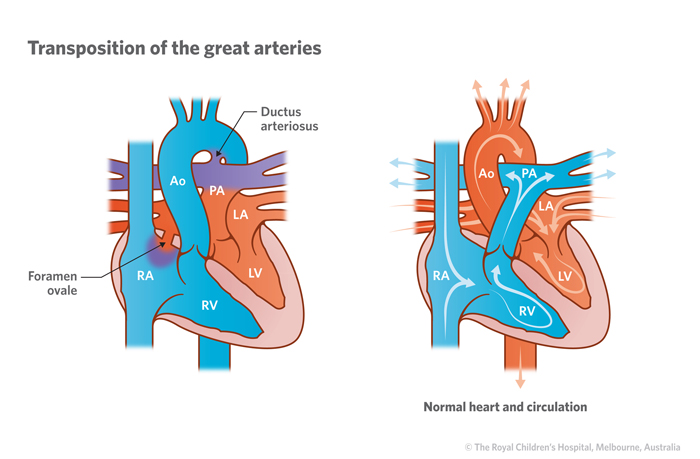Transposition of the great arteries (TGA) is congenital heart defect where the two major arteries are reversed (‘transposed’) from their normal position. The aorta arises from the right ventricle instead of the left ventricle and the pulmonary artery arises from the left ventricle instead of the right. This creates two separate circuits: one with deoxygenated blue blood and the other with oxygen-rich red blood. Communication between these two circuits is critical so oxygen-rich red blood can reach the organs in the body and oxygen-poor blue blood can get to the lungs to collect oxygen.

Diagnosis
Tests to help diagnose TGA include:
- Electrocardiogram (ECG) – measures the electrical activity of the heart.
- Echocardiogram (Echo) – uses sounds waves to produce a moving picture of the heart.
- CT Scan – an X-ray with dye injected to highlight blood vessels.
These tests are carried out because a doctor has heard a heart murmur when examining a child with a stethoscope, or the condition is picked up during a pregnancy ultrasound. The condition may also be identified at birth if the child has an immediate change of skin colour.
Treatment
TGA is a congenital heart defect which requires surgery in the first few weeks of a child’s life to correct.
Before surgery, the immediate treatment options at birth include a procedure called balloon atrial septostomy (BAS) or medication called Prostaglandin (Prostin).
Balloon atrial septostomy
A catheter with a balloon at its tip is inserted into the vein in the umbilical cord stump or into a big vein in the leg and pushed up into the heart. The balloon is inflated in the left atrium and pulled back into the right atrium to enlarge the hole (the foramen ovale) between the two and allow enough mixing of blue and red blood until surgery can be performed.
Prostaglandin (Prostin)
This medication delivered intravenously to keep the Ductus Arteriosus open. This provides another site for “blue” blood and “red” blood to mix between the two circuits.
Surgery
Surgery is essential to correct this heart defect. The surgery is called an arterial switch operation. The two great arteries, the aorta and pulmonary artery, are ‘switched’ so that the aorta now arises from the left ventricle and the pulmonary artery arises from the right ventricle. The coronary arteries will also be ‘switched’.
Developed by the Cardiology Department, Queensland Children's Hospital. We acknowledge the input of consumers and carers.
Resource ID: FS258. Reviewed: January 2024
Illustrations republished with permission from The Royal Children's Hospital, Melbourne, Australia. Images subject to copyright.
Disclaimer: This information has been produced by healthcare professionals as a guideline only and is intended to support, not replace, discussion with your child’s doctor or healthcare professionals. Information is updated regularly, so please check you are referring to the most recent version. Seek medical advice, as appropriate, for concerns regarding your child’s health.